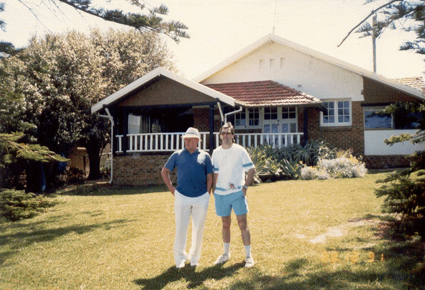
The author (left) snapped in front of "Wyewurk"
in 1988 in the company of Barry Conyngham, then Professor
of Creative Arts at Wollongong University, and later Vice-Chancellor
of Southern Cross University(and now, at time of writing,
Dean of the Victorian College of the Arts)
BEFORE
WE WENT to Perth we had, the previous year, formed the DH
Lawrence Society of Australia. This had come out of a campaign
to save "Wyewurk", the bungalow in Thirroul in
which Lawrence stayed and where he wrote Kangaroo.
Thanks to a quirk in local tenancy laws, Lawrence's "cottage
by the sea" had remained, occupied by a single "protected"
tenant since the early 1940s, preserved in almost the same
state that Lawrence had left it in August 1922.
We know this because one of the people Nehls commissioned
to look into Lawrence's time in Australia - the Sydney journalist
Fred Esch - had, in 1955-56, interviewed its owner, Mrs
Southwell, and had gone down to Thirroul and taken photos
of its interior and exterior.
After my first Lawrence article was published, I met and
interviewed Esch in Sydney in mid-1976. He urged me to try
and get "Wyewurk" preserved.
The following year Sandra and I made representations to
the NSW Minister of Planning, Paul Landa (with whom I had
gone to school), to have "Wyewurk" either acquired
or otherwise preserved in the condition Lawrence had portrayed
it in Kangaroo.
Alas, he did nothing. (So much for Sydney High's old-boy
network.)
In 1981, after the "sitting tenant" moved out,
and following the death of Mrs Southwell, the house came
on the market.
Had we known
this - we were in England at the time - we would have moved
hell and high water to have it purchased and preserved.
We would have happily bought it ourselves if necessary.
However, a local estate agent learned of its vacant state
and immediately made an offer to the Southwell family, which
was accepted. (He conducted, we were told by the Southwell
family, a "dutch auction", at which he was the
only bidder - though I am, of course, not implying he didn't
pay a fair price for the cottage.)
Nevertheless, "Wyewurk" thus fell into property-owning,
rather than literary or heritage, hands.
When, on our permanent return from London in 1987, we learned
of its new ownership, we successfully convinced the current
Planning Minister, Bob Carr (with whom I had worked on The
Bulletin - that old-boy network still worked), to put
a preservation-order on the precious building, which he
managed to arrange.

|